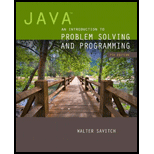
Write a static method blur (double [] [] picture) that you could use on a part of a picture file to obscure a detail such as a person's face or a license plate number. This method computes the weighted averages of the values in picture and returns them in a new two-dimensional array. To find a weighted average of a group of numbers, you count some of them more than others. Thus, you multiply each item by its weight, add these products together, and divide the result by the sum of the weights.
For each element in picture, compute the weighted average of the element and its immediate neighbors. Store the result in a new two-dimensional array in the same position that the element occupies in picture. This new array is the one the method returns.
The neighbors of an element in picture can be above, below, to the left of, and to the right of it, either vertically, horizontally, or diagonally. So each weighted average in the new array will be a combination of up to nine values from the array picture. A corner value will use only four values: itself and three neighbors. An edge value will use only six values: itself and five neighbors. But an interior value will use nine values: itself and eight neighbors. So you will need to treat the corners and edges separately from the other cells.
The weights to use are:
![Chapter 7, Problem 21E, Write a static method blur (double [] [] picture) that you could use on a part of a picture file to , example 1](http://dev-ingestion-image-output.s3-website-us-east-1.amazonaws.com/9780134462035/Chapter-7/images/62035-7-21e-question-digital_image_001.png)
The element itself has the highest weight of 4, the horizontal and vertical neighbors have a weight of 2, and the diagonal neighbors have a weight of 1.
For example, suppose the values in picture are
![Chapter 7, Problem 21E, Write a static method blur (double [] [] picture) that you could use on a part of a picture file to , example 2](http://dev-ingestion-image-output.s3-website-us-east-1.amazonaws.com/9780134462035/Chapter-7/images/62035-7-21e-question-digital_image_002.png)
and the new array is called result. In assigning weights, we will arbitrarily start with an element and consider neighbors in a clockwise direction. Thus, the interior value in result [1] [1] is equal to
To arrive at this equation, we started with the element at picture [1] [1] and then, beginning with the neighbor to the right, we considered neighbors in a clockwise direction. The corner value in result [0] [0] is equal to
Note that picture [0] [0] has fewer neighbors than an interior value such as picture [1] [1]. The same is true for an edge value such as picture [0] [1]. Thus, the edge value in result [0] [1] is equal to
The final array, result, would be
![Chapter 7, Problem 21E, Write a static method blur (double [] [] picture) that you could use on a part of a picture file to , example 3](http://dev-ingestion-image-output.s3-website-us-east-1.amazonaws.com/9780134462035/Chapter-7/images/62035-7-21e-question-digital_image_003.png)
Want to see the full answer?
Check out a sample textbook solution
Chapter 7 Solutions
Java: An Introduction to Problem Solving and Programming (7th Edition)
Additional Engineering Textbook Solutions
Elementary Surveying: An Introduction To Geomatics (15th Edition)
Thinking Like an Engineer: An Active Learning Approach (4th Edition)
Starting Out with Java: From Control Structures through Data Structures (4th Edition) (What's New in Computer Science)
Starting Out With Visual Basic (8th Edition)
INTERNATIONAL EDITION---Engineering Mechanics: Statics, 14th edition (SI unit)
- Briefly describe the issues involved in using ATM technology in Local Area Networksarrow_forwardFor this question you will perform two levels of quicksort on an array containing these numbers: 59 41 61 73 43 57 50 13 96 88 42 77 27 95 32 89 In the first blank, enter the array contents after the top level partition. In the second blank, enter the array contents after one more partition of the left-hand subarray resulting from the first partition. In the third blank, enter the array contents after one more partition of the right-hand subarray resulting from the first partition. Print the numbers with a single space between them. Use the algorithm we covered in class, in which the first element of the subarray is the partition value. Question 1 options: Blank # 1 Blank # 2 Blank # 3arrow_forward1. Transform the E-R diagram into a set of relations. Country_of Agent ID Agent H Holds Is_Reponsible_for Consignment Number $ Value May Contain Consignment Transports Container Destination Ф R Goes Off Container Number Size Vessel Voyage Registry Vessel ID Voyage_ID Tonnagearrow_forward
- I want to solve 13.2 using matlab please helparrow_forwarda) Show a possible trace of the OSPF algorithm for computing the routing table in Router 2 forthis network.b) Show the messages used by RIP to compute routing tables.arrow_forwardusing r language to answer question 4 Question 4: Obtain a 95% standard normal bootstrap confidence interval, a 95% basic bootstrap confidence interval, and a percentile confidence interval for the ρb12 in Question 3.arrow_forward
- using r language Obtain a bootstrap t confidence interval estimate for the correlation statistic in Example 8.2 (law data in bootstrap).arrow_forwardusing r language Compute a jackknife estimate of the bias and the standard error of the correlation statistic in Example 8.2.arrow_forwardusing r languagearrow_forward
 EBK JAVA PROGRAMMINGComputer ScienceISBN:9781337671385Author:FARRELLPublisher:CENGAGE LEARNING - CONSIGNMENT
EBK JAVA PROGRAMMINGComputer ScienceISBN:9781337671385Author:FARRELLPublisher:CENGAGE LEARNING - CONSIGNMENT Microsoft Visual C#Computer ScienceISBN:9781337102100Author:Joyce, Farrell.Publisher:Cengage Learning,Programming Logic & Design ComprehensiveComputer ScienceISBN:9781337669405Author:FARRELLPublisher:Cengage
Microsoft Visual C#Computer ScienceISBN:9781337102100Author:Joyce, Farrell.Publisher:Cengage Learning,Programming Logic & Design ComprehensiveComputer ScienceISBN:9781337669405Author:FARRELLPublisher:Cengage C++ Programming: From Problem Analysis to Program...Computer ScienceISBN:9781337102087Author:D. S. MalikPublisher:Cengage Learning
C++ Programming: From Problem Analysis to Program...Computer ScienceISBN:9781337102087Author:D. S. MalikPublisher:Cengage Learning C++ for Engineers and ScientistsComputer ScienceISBN:9781133187844Author:Bronson, Gary J.Publisher:Course Technology Ptr
C++ for Engineers and ScientistsComputer ScienceISBN:9781133187844Author:Bronson, Gary J.Publisher:Course Technology Ptr EBK JAVA PROGRAMMINGComputer ScienceISBN:9781305480537Author:FARRELLPublisher:CENGAGE LEARNING - CONSIGNMENT
EBK JAVA PROGRAMMINGComputer ScienceISBN:9781305480537Author:FARRELLPublisher:CENGAGE LEARNING - CONSIGNMENT





